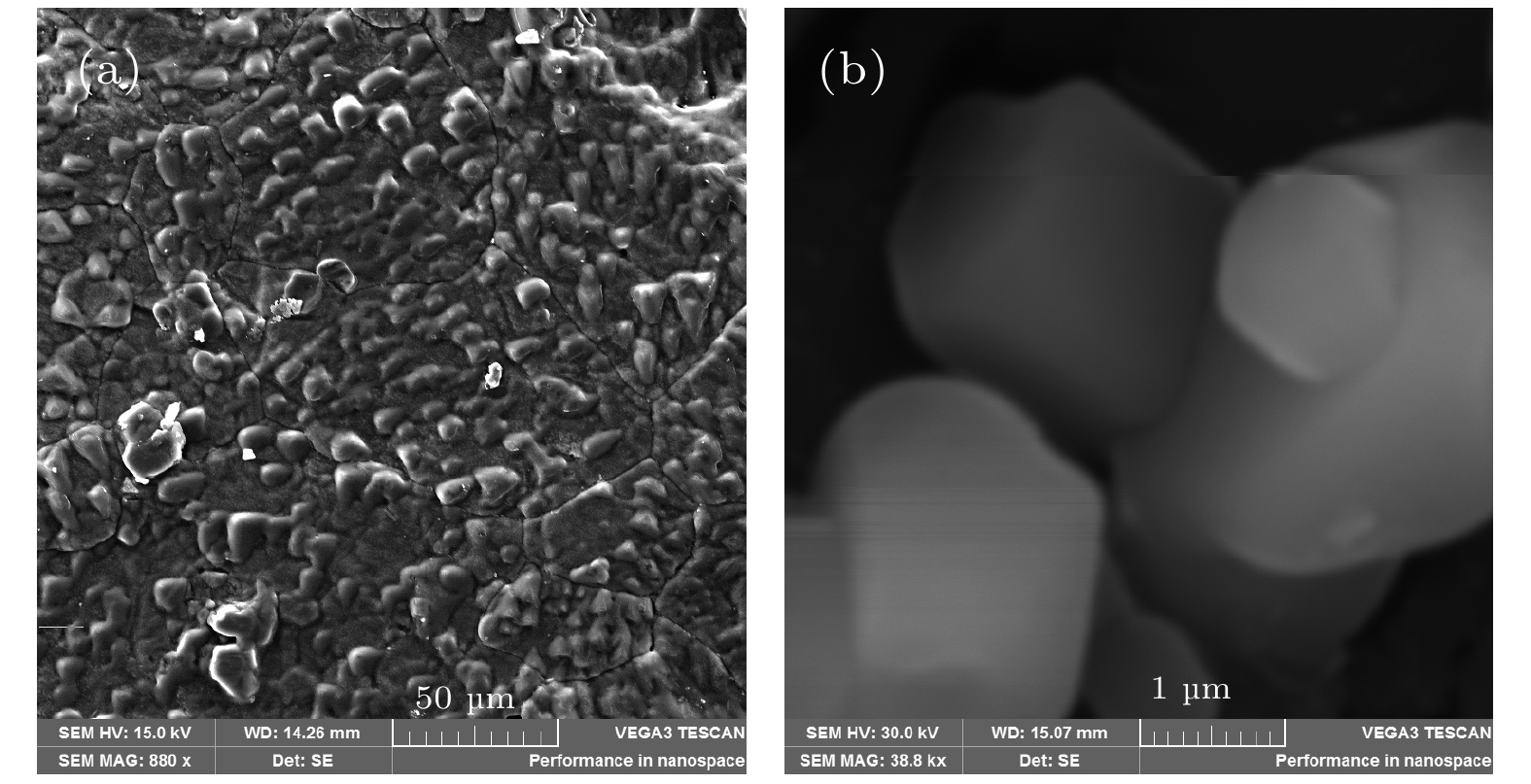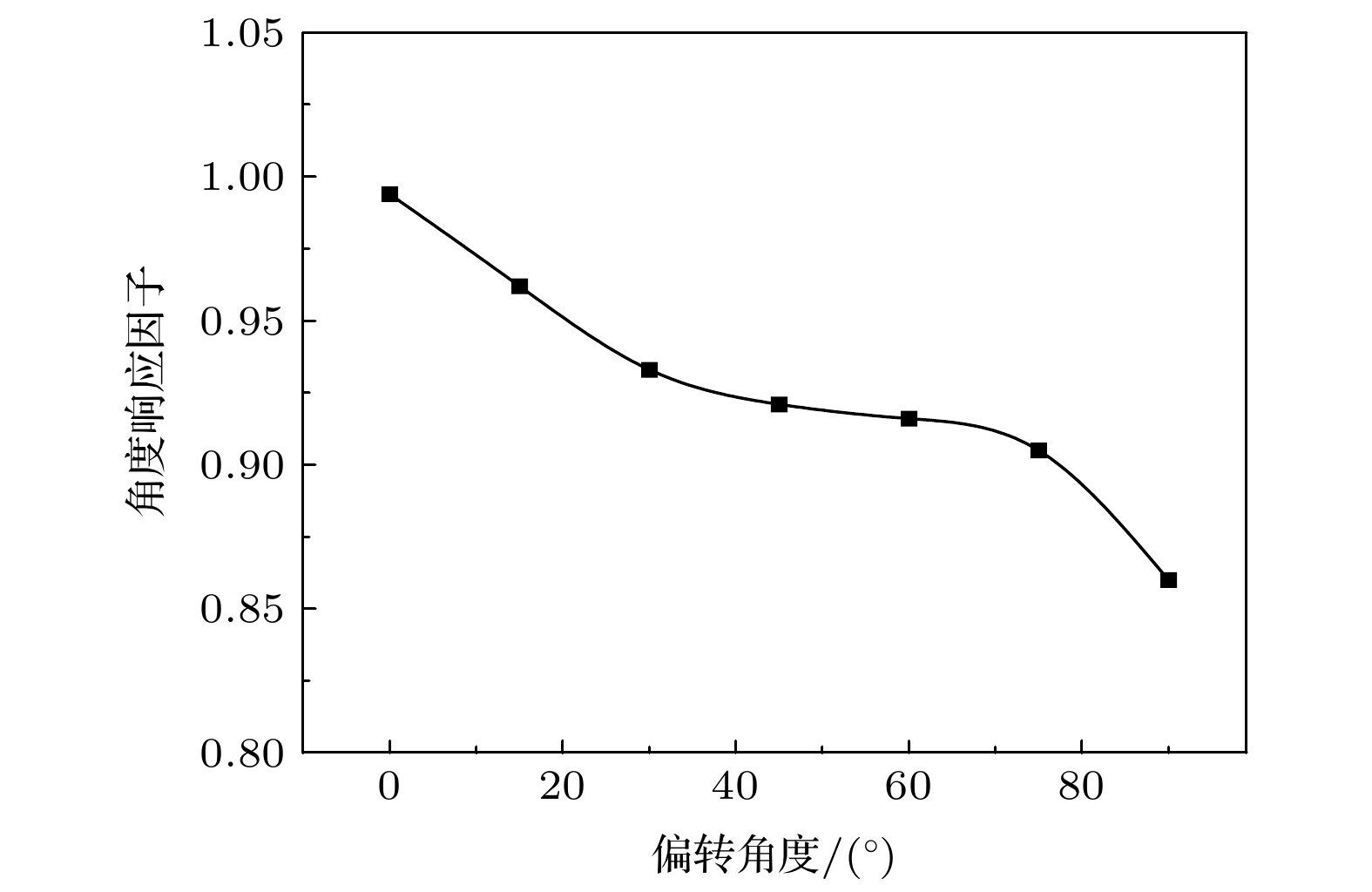-
In this paper, NaCl: Cu circular dose tablets with a size of 5×1.8mm are prepared by sintering pure NaCl and CuCl powder as raw materials. They are placed in a four-element shell and sealed with plastic film to overcome the moisture absorption of the material. Their photoluminescence characteristics are studied by using an Inlight 200 automatic photoluminescence measurement system. The results show that the X-ray characteristic peaks of NaCl: Cu sintered at 650 ℃ and 400 ℃ appear at 27°, 32°, 45°, 56°, 66°, 75° and 84° respectively. Compared with the data given by XRD standard card of pure NaCl crystal (pdf-#88-2300), those peaks of the sample sintered at 650 ℃ are more consistent with the data given by the standard card. In the scanning electron microscope image, it can be seen that the grains are wholly welded and closely connected, and the characteristic grains in the sintering process have good welding effect. After Cu+ ion doping, the lattice structure of NaCl is slightly deformed. After high-temperature sintering, the mass transfer of Cu+ ions occurs at an atomic level in NaCl, and the particles are combined into a coherent solid structure. For X/γ-rays, the photoluminescence response of NaCl:Cu dose sheet to low-energy rays is higher than that of the same kind of rays with high energy. When using NaCl:Cu dose sheet to calculate the cumulative photoluminescence dose, it is necessary to consider the ray category and ray energy of the radiation source at the radiation site. The photoluminescence curve of NaCl:Cu dose sheet has typical exponential attenuation characteristics. The deflection angle of dose sheet has influence on the measured value: the greatest influence extent is 13.5%. With the increase of deflection angle of dose sheet, the area irradiated by γ-ray decreases, and the response of internal lattices to γ-ray decreases slightly. The uniformity of NaCl: Cu raw material particle sizes has a great influence on the distribution consistency of photoluminescence response of dose tablets. The decrease of sample particle size during tablet pressing can improve the contact surface area between NaCl and CuCl. The increase of contact surface area can improve the diffusion and transfer efficiency of Cu+ ions, increase the number of dose traps in the crystal, and make the overall count higher. When the particle sizes are more uniform, the Cu+ ion transferefficiencies and quantities of different dose tablets are close, the difference in the number of dose traps is reduced, and the photoluminescence sensitivities are closer. The coefficient of variation of the repeatability test experiment is 2.28%. The consistency of the repeated measurement data is good. The lattice structure and lattice defects of the material are not changed in the process of photoluminescence measurement and photoannealing. In a dose range of 1-1000mgy, with the increase of irradiation dose, the photoluminescence response of NaCl: Cu and NaCl dose tablets gradually increase and show a good linear relationship. The photoluminescence response of NaCl: Cu is 2-to-4 times higher than that of NaCl dose tablets. The NaCl: Cu dose tablets prepared by the sintering method can be used as dosimeters for monitoring personal or environmental dose.
-
Keywords:
- NaCl:Cu /
- optically stimulated luminescent /
- sintering method /
- linear relationship
[1] 张纯祥, 林理彬, 梁宝鎏, 唐强, 李德卉, 罗达玲 2004 01 291
 Google Scholar
Google Scholar
Zhang C X, Lin L B, Liang B L, Tang Q, Li D H, Luo D L 2004 Acta Phys. Sin. 01 291
 Google Scholar
Google Scholar
[2] 杨新波, 李红军, 徐军, 程艳, 苏良碧, 唐强 2008 57 7900
 Google Scholar
Google Scholar
Yang X B, Li H J, Cheng Y, Su L B, Tang Q 2008 Acta Phys. Sin. 57 7900
 Google Scholar
Google Scholar
[3] 胡克艳, 李红军, 徐军, 杨秋红, 苏良碧, 唐强 2012 61 482
 Google Scholar
Google Scholar
Hu K Y, Li H J, Xu J, Yang Q H, Su L B, Tang Q 2012 Acta Phys. Sin. 61 482
 Google Scholar
Google Scholar
[4] 吴丽, 王倩, 李国栋, 窦巧娅, 吉旭 2016 65 306
 Google Scholar
Google Scholar
Wu L, Wang Q, Li G D, Dou Q Y, Ji X 2016 Acta Phys. Sin. 65 306
 Google Scholar
Google Scholar
[5] Elashmawy M, 2018 Nucl. Instrum. Meth. B. 423 49
 Google Scholar
Google Scholar
[6] Hernández J A, Camarillo E G, Muñoz G, Flores C J, Cabrera E B, Jaque F, Romero J J, Garcı́a S J, Murrieta H S 2001 Opt. Mater. 17 491
 Google Scholar
Google Scholar
[7] Cruz-Zaragoza E, Barboza-Flores M, Chernov V, Meléndrez R, Ramos B S, Negrón-Mendoza A, Hernández J M, Murrieta H 2006 Radiat. Prot. Dosim. 119 102
 Google Scholar
Google Scholar
[8] Cruz-Zaragoza E, Ortiz A, Furetta C, Flores J C, Hernández A J, Murrieta S H 2011 Appl. Radiat. Isot. 69 334
 Google Scholar
Google Scholar
[9] Bhujbal P M, Dhoble S J 2012 J. Biomed. Mater. Res. B 100 2148
[10] Nagaoka Y, Adachi S 2014 J. Lumin. 145 797
 Google Scholar
Google Scholar
[11] Bernal R, Cruz-Vázquez C, Brown F, Tostado-García W, Pérez-Salas R, Castaño V M 2014 Electron. Mater. Lett. 10 863
 Google Scholar
Google Scholar
[12] Gaikwad S U, Patil R R, Kulkarni M S, Bhatt B C, Moharil S V 2016 Am. J. Phys. 84 020510
 Google Scholar
Google Scholar
[13] Gaikwad S U, Patil R R, Kulkarni M S, Dudhe C M, Moharil S V 2020 Radiat. Prot. Dosim. 192 1
 Google Scholar
Google Scholar
[14] McKeever S W S 1985 Nucl, Instrum. Meth. A. 241 620
 Google Scholar
Google Scholar
[15] 李燕飞, 陈建新, 周迎春 2006 个人与环境监测用X, γ辐射热释光剂量测量装置检定规程 (北京: 中国质检出版社) 第12页
Li Y F, Chen J X, Zhou Y C 2003 Verification Regulation of X/γ-ray Thermoluminescence Dosimeter for Personal and Environmental Monitoring (Beijing: China Quality Inspection press) p12 (in Chinese)
[16] 郭志军, 王川, 曾进忠 2014 个人和环境监测用热释光剂量测量系统 (北京: 中国标准出版社) 第21页
Guo Z J, Wang C, Zeng J Z 2014 Thermoluminescence Dosimetry System for Personal and Environmental Monitoring (Beijing: China Standards Press) p21 (in Chinese)
[17] Krishnakumar D N, Perumal R N 2020 J. Mater. Sci-mater. El. 5 4294
 Google Scholar
Google Scholar
[18] 韩斌, 冯天成, 陈伟, 李德红, 吴迪, 寿金翔 2017 核电子学与探测技术 37 1253
Han B, Feng T D, Chen W, Li D H, Wu D, Shou J X 2017 Nucl. Electron. Detect. Technol. 37 1253 (in Chinese)
[19] 赵修良, 陈斌, 何淑雅, 刘丽艳, 孙娜, 贺三军 2018 核电子学与探测技术 38 521
 Google Scholar
Google Scholar
Zhao X L, Chen B, He S Y, Liu L Y, Su N, He S J 2018 Nucl. Electron. Detect. Technol. 38 521
 Google Scholar
Google Scholar
[20] Mehrabi M, Zahedifar M, Saeidi-Sogh Z, Ramazani-Moghaddam-Arani A, Sadeghi E, Harooni S 2017 Nucl. Instrum. Meth. A 846 87
 Google Scholar
Google Scholar
-
表 1 重复性实验测量数据
Table 1. Measurement data of repeatability experiment.
测量次数 1组响应 2组响应 3组响应 4组响应 平均响应 1 19145 17132 15397 17269 17235.75 2 18667 15736 17354 19041 17699.5 3 16395 18879 17437 18975 17921.5 4 17576 18664 17485 18531 18064 5 18111 18978 19009 17802 18475 -
[1] 张纯祥, 林理彬, 梁宝鎏, 唐强, 李德卉, 罗达玲 2004 01 291
 Google Scholar
Google Scholar
Zhang C X, Lin L B, Liang B L, Tang Q, Li D H, Luo D L 2004 Acta Phys. Sin. 01 291
 Google Scholar
Google Scholar
[2] 杨新波, 李红军, 徐军, 程艳, 苏良碧, 唐强 2008 57 7900
 Google Scholar
Google Scholar
Yang X B, Li H J, Cheng Y, Su L B, Tang Q 2008 Acta Phys. Sin. 57 7900
 Google Scholar
Google Scholar
[3] 胡克艳, 李红军, 徐军, 杨秋红, 苏良碧, 唐强 2012 61 482
 Google Scholar
Google Scholar
Hu K Y, Li H J, Xu J, Yang Q H, Su L B, Tang Q 2012 Acta Phys. Sin. 61 482
 Google Scholar
Google Scholar
[4] 吴丽, 王倩, 李国栋, 窦巧娅, 吉旭 2016 65 306
 Google Scholar
Google Scholar
Wu L, Wang Q, Li G D, Dou Q Y, Ji X 2016 Acta Phys. Sin. 65 306
 Google Scholar
Google Scholar
[5] Elashmawy M, 2018 Nucl. Instrum. Meth. B. 423 49
 Google Scholar
Google Scholar
[6] Hernández J A, Camarillo E G, Muñoz G, Flores C J, Cabrera E B, Jaque F, Romero J J, Garcı́a S J, Murrieta H S 2001 Opt. Mater. 17 491
 Google Scholar
Google Scholar
[7] Cruz-Zaragoza E, Barboza-Flores M, Chernov V, Meléndrez R, Ramos B S, Negrón-Mendoza A, Hernández J M, Murrieta H 2006 Radiat. Prot. Dosim. 119 102
 Google Scholar
Google Scholar
[8] Cruz-Zaragoza E, Ortiz A, Furetta C, Flores J C, Hernández A J, Murrieta S H 2011 Appl. Radiat. Isot. 69 334
 Google Scholar
Google Scholar
[9] Bhujbal P M, Dhoble S J 2012 J. Biomed. Mater. Res. B 100 2148
[10] Nagaoka Y, Adachi S 2014 J. Lumin. 145 797
 Google Scholar
Google Scholar
[11] Bernal R, Cruz-Vázquez C, Brown F, Tostado-García W, Pérez-Salas R, Castaño V M 2014 Electron. Mater. Lett. 10 863
 Google Scholar
Google Scholar
[12] Gaikwad S U, Patil R R, Kulkarni M S, Bhatt B C, Moharil S V 2016 Am. J. Phys. 84 020510
 Google Scholar
Google Scholar
[13] Gaikwad S U, Patil R R, Kulkarni M S, Dudhe C M, Moharil S V 2020 Radiat. Prot. Dosim. 192 1
 Google Scholar
Google Scholar
[14] McKeever S W S 1985 Nucl, Instrum. Meth. A. 241 620
 Google Scholar
Google Scholar
[15] 李燕飞, 陈建新, 周迎春 2006 个人与环境监测用X, γ辐射热释光剂量测量装置检定规程 (北京: 中国质检出版社) 第12页
Li Y F, Chen J X, Zhou Y C 2003 Verification Regulation of X/γ-ray Thermoluminescence Dosimeter for Personal and Environmental Monitoring (Beijing: China Quality Inspection press) p12 (in Chinese)
[16] 郭志军, 王川, 曾进忠 2014 个人和环境监测用热释光剂量测量系统 (北京: 中国标准出版社) 第21页
Guo Z J, Wang C, Zeng J Z 2014 Thermoluminescence Dosimetry System for Personal and Environmental Monitoring (Beijing: China Standards Press) p21 (in Chinese)
[17] Krishnakumar D N, Perumal R N 2020 J. Mater. Sci-mater. El. 5 4294
 Google Scholar
Google Scholar
[18] 韩斌, 冯天成, 陈伟, 李德红, 吴迪, 寿金翔 2017 核电子学与探测技术 37 1253
Han B, Feng T D, Chen W, Li D H, Wu D, Shou J X 2017 Nucl. Electron. Detect. Technol. 37 1253 (in Chinese)
[19] 赵修良, 陈斌, 何淑雅, 刘丽艳, 孙娜, 贺三军 2018 核电子学与探测技术 38 521
 Google Scholar
Google Scholar
Zhao X L, Chen B, He S Y, Liu L Y, Su N, He S J 2018 Nucl. Electron. Detect. Technol. 38 521
 Google Scholar
Google Scholar
[20] Mehrabi M, Zahedifar M, Saeidi-Sogh Z, Ramazani-Moghaddam-Arani A, Sadeghi E, Harooni S 2017 Nucl. Instrum. Meth. A 846 87
 Google Scholar
Google Scholar
Catalog
Metrics
- Abstract views: 8709
- PDF Downloads: 68
- Cited By: 0















 DownLoad:
DownLoad:






